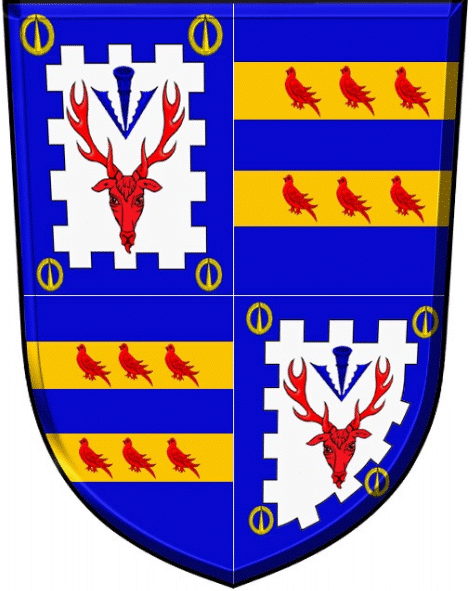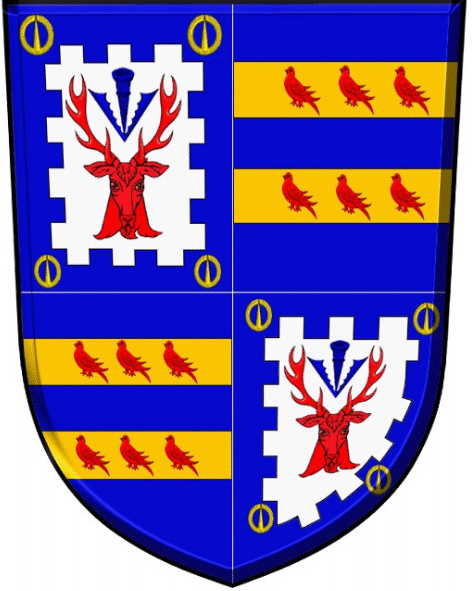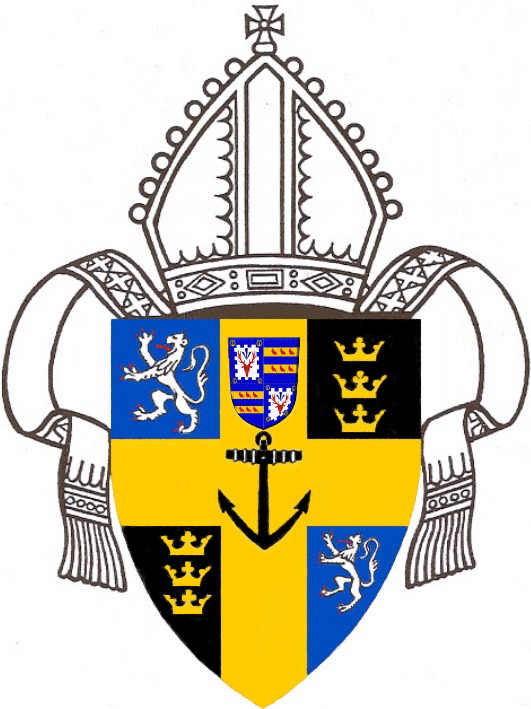DIOCESE OF CAPE TOWN (Anglican)
Diocese established in 1847, a division of the Diocese of Calcutta.
Cathedral: St George the Martyr, Cape Town.
Archbishop’s residence: Bishopscourt, Wynberg.
Arms apparently adopted in 1847 by Bishop Robert Gray. The blazon reads:
Quarterly, azure and sable: I and IV, a lion rampant argent; II and III: three open crowns palewise or; on a cross throughout also or, an anchor in fess point sable and in honour point an inescutcheon for Burdett-Coutts, to wit: Quarterly, I and IV: argent a stag’s head caboshed gules, between the attires a pheon azure, the whole within a border embattled of the last charged with four buckles or (for Coutts): II and III: azure, two bars or, each charged with three martlets gules (for Burdett).
The arms reflect four distinct elements: the service of Robert Gray in two English dioceses, the location of Cape Town in the Cape Colony, and the benefactress of the diocese, Angela Burdett-Coutts.
Brownell writes:
“The first and fourth quarters, together with the gold cross, are taken from the arms of the See of Durham, Robert Gray the first Bishop of Cape Town having been a prebendary of Durham before his consecration.
“The second and third quarters are the arms of the See of Bristol, Robert Gray’s father having been Bishop of Bristol, and Robert his father’s chaplain.

“The inescutcheon is in memory of the generosity of Angela Burdett-Coutts (created Baroness Burdett-Coutts in 1871), whose endowment made possible the founding of the diocese.”
Brownell remarks of the inescutcheon that it “is difficult to reproduce successfully in miniature”.

So for clarity, the shield is shown full-size here, in two versions. The first (at right) shows the arms as actually borne by Miss Burdett-Coutts, incorporating an error.
This arose because the grant from the College of Arms contained a discrepancy in that the illumination (as it is called) showed as stag’s head caboshed, while the blazon (the written description) uses the term erased.
Legal precedent lays it down that where such a discrepancy exists, the blazon has priority. However, the error was not noticed until the 1950s, when the College of Arms was processing an application from the diocese. Consequently, during Miss Burdett-Coutts’s lifetime the caboshed version was in use.
The second illustration (at left) shows the corrected form, with the head erased. It is this form of the head that appears in the current arms of the diocese.
About the diocese:
When Robert Gray arrived in Cape Town on 1 September 1848, he had an enormous task ahead of him.
Previously the Bishop of Calcutta had been in charge of all Anglican work between St Helena island and Tasmania. Now his workload had been significantly diminished through the consecration of bishops for Cape Town, Adelaide (South Australia), Melbourne (Victoria) and Newcastle (Queensland).
But Gray’s diocese itself was immense, stretching from St Helena to an undefined limit on the east coast of Africa. In August 1848 he set out on a journey across the Cape Colony to King William’s Town, discovering that there was far too much work for a single bishop. This was to be the first of many journeys.
In 1853 the first part of his dream for expanded work came to fruition with the consecration of John William Colenso and John Armstrong as bishops respectively of Natal and Grahamstown. Gray resigned his See, obtaining new Letters Patent as Bishop of Cape Town and Metropolitan of South Africa.
For more about his journeys, see this article, and for the complications that arose out of these Letters Patent, see this article.
Before Gray’s death in 1872, new bishops were also consecrated for St Helena (1859), what was at the time styled the Orange River Free State (1863) and Zululand (1870). In the year following his death, Bishop Henry Callaway was also sent to Lusikisiki to found the Diocese of St John’s, Kaffraria (as it was styled at the time).
In 1878 Henry Bousfield was consecrated Bishop of Pretoria, in 1891 G W H Knight-Bruce became Bishop of Mashonaland, and in 1893 W E Smyth became Bishop of Lebombo. These new dioceses being in faraway places, their creation did not reduce the area of the Diocese of Cape Town, but they added considerably to the responsibility placed on the shoulders of the metropolitan.
In 1911, the year after Union, the area of the diocese was reduced considerably through the creation of the dioceses of
George and of Kimberley and Kuruman. The George Diocese, the creation of which was a dream of Bishop Gray’s, was created out of parishes previously falling under both Cape Town and
Grahamstown, while Kimberley and Kuruman took up most of the surface area of the northern part of the Cape Province, not only north of the Orange River, but also a good distance south of the river.
This situation remained until the Cape Town Diocese received the grant of its arms (in altered form) in 1952.
Bishops: The first bishop was Robert Gray, consecrated in Westminster Abbey in 1847, arrived in Cape Town 1848, and made metropolitan in 1853. His arms are showin on this page.
His first successor was William West Jones (consecrated 1874, created archbishop 1899). The See has always been styled a diocese, rather than an archdiocese.
Further archbishops during the period covered were: W M Carter (1909), Francis Robinson Phelps (1931), J R Darbyshire (1938), and Geoffrey Clayton (1948).




